
Scaphoid Fracture of the Wrist
Information on scaphoid fractures is also available in Spanish: Fractura del hueso escafoides de la muñeca.
A scaphoid (navicular) fracture is a break in one of the small bones of the wrist. This type of fracture occurs most often after a fall onto an outstretched hand. Symptoms of a scaphoid fracture typically include pain and tenderness in the area just below the base of the thumb. These symptoms may worsen when you try to pinch or grasp something.
Treatment for a scaphoid fracture can range from casting to surgery, depending on the fracture's severity and location on the bone. Because portions of the scaphoid have a poor blood supply—and a fracture can further disrupt the flow of blood to the bone—complications with the healing process are common.
Anatomy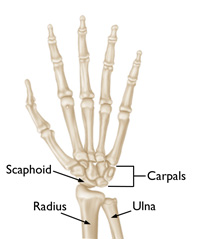 The scaphoid is one of the small carpal bones in the wrist.
Reproduced with permission from JF Sarwark, ed: Essentials of Musculoskeletal Care, ed 5. Rosemont, IL, American Academy of Orthopaedic Surgeons, 2016.
The scaphoid is one of the small carpal bones in the wrist.
Reproduced with permission from JF Sarwark, ed: Essentials of Musculoskeletal Care, ed 5. Rosemont, IL, American Academy of Orthopaedic Surgeons, 2016.
The wrist is formed by the two bones of the forearm—the radius and the ulna—and eight small carpal bones. The carpal bones are arranged in two rows at the base of the hand. There are four bones in each row.
The scaphoid bone is one of the carpal bones on the thumb side of the wrist, just above the radius. The bone is important for both motion and stability in the wrist joint. The word "scaphoid" comes from the Greek term for "boat." The scaphoid bone resembles a boat with its relatively long, curved shape.
The scaphoid bone can most easily be identified when your thumb is held in a "hitch-hiking" position. It is located at the base of the hollow made by the thumb tendons. Often referred to as the "anatomic snuffbox," this area is typically the site of tenderness or pain when a fracture occurs.
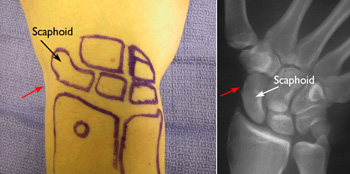 Photograph and x-ray showing the location of the scaphoid in the wrist. The red arrows indicate the location of the anatomic snuffbox.
Description
Photograph and x-ray showing the location of the scaphoid in the wrist. The red arrows indicate the location of the anatomic snuffbox.
Description
A scaphoid fracture is usually described by its location within the bone. Most commonly, the scaphoid breaks in its mid-portion, called the "waist." Fractures can also occur at both the proximal and distal ends of the bone.
Scaphoid fractures are classified according to the severity of displacement--or how far the pieces of bone have moved out of their normal position:
- Non-displaced fracture. In this type of fracture, the bone fragments line up correctly.
- Displaced fracture. In this type of fracture, the bone fragments have moved out of their normal position. There may be gaps between the pieces of bone or fragments may overlap each other.
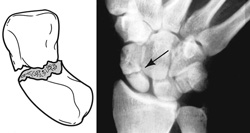 Illustration and x-ray showing a break in the mid-portion, or "waist," of the scaphoid. This is the most common location for a fracture.
Reproduced with permission from JF Sarwark, ed: Essentials of Musculoskeletal Care, ed 5. Rosemont, IL, American Academy of Orthopaedic Surgeons, 2016.
Cause
Illustration and x-ray showing a break in the mid-portion, or "waist," of the scaphoid. This is the most common location for a fracture.
Reproduced with permission from JF Sarwark, ed: Essentials of Musculoskeletal Care, ed 5. Rosemont, IL, American Academy of Orthopaedic Surgeons, 2016.
Cause
A scaphoid fracture usually occurs when you fall onto an outstretched hand, with your weight landing on your palm. The end of the larger forearm bone (the radius) may also break in this type of fall, depending on the position of the hand on landing.
The injury can also happen during sports activities or motor vehicle collisions.
Fractures of the scaphoid occur in people of all ages, including children.There are no specific risk factors or diseases that make you more likely to experience a scaphoid fracture. Some studies have shown that using wrist guards during high-energy activities like inline skating and snowboarding can help decrease your chance of breaking a bone around the wrist.
SymptomsScaphoid fractures usually cause pain and swelling in the anatomic snuffbox and on the thumb side of the wrist. The pain may be severe when you move your thumb or wrist, or when you try to pinch or grasp something.
Unless your wrist is deformed, it might not be obvious that your scaphoid bone is broken. With some scaphoid fractures, the pain is not severe and may be mistaken for a wrist sprain.
Pain in your wrist that does not go away within a day of injury may be a sign of a fracture—so it is important to see a doctor if your pain persists. Prompt treatment of a scaphoid fracture will help avoid potential complications.
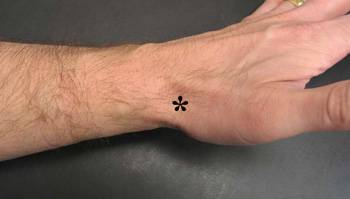 Symptoms of a scaphoid fracture often occur in the anatomic snuffbox at the base of the thumb.
Doctor Examination
Symptoms of a scaphoid fracture often occur in the anatomic snuffbox at the base of the thumb.
Doctor Examination
Physical Examination
During the exam, your doctor will talk with you about your general health and will ask you to describe your symptoms. He or she will want to know how your injury occurred.
Your doctor will examine your wrist. With most fractures, there will be tenderness directly over the scaphoid in the anatomic snuffbox. Your doctor will also look for:
- Swelling
- Bruising
- Loss of motion
Tests
X-rays. X-rays provide images of dense structures, such as bone. Your doctor will order an x-ray to help determine if you have a scaphoid fracture and whether the broken pieces of bone are displaced. An x-ray will also help your doctor determine if you have any other fractures.
In some cases, a scaphoid fracture does not show up on an x-ray right away. If your doctor suspects that you have a fracture but it is not visible on x-ray, he or she may recommend that you wear a wrist splint or cast for 2 to 3 weeks and then return for a follow-up x-ray. Often, scaphoid fractures become visible on x-ray only after a period of time. During this waiting period, you should wear your splint or cast and avoid activities that might cause further injury.
Magnetic resonance imaging (MRI) scan. Your doctor may order an MRI to learn more about the bones and soft tissues in your wrist. An MRI can sometimes show a fracture of the scaphoid before it can be seen on x-ray.
Computerized tomography (CT) scan. A CT scan can be helpful in revealing a fracture of the scaphoid and can also show whether the bones are displaced. Your doctor will use information from the CT scan to help determine your treatment plan.
TreatmentThe treatment your doctor recommends will depend on a number of factors, including:
- The location of the break in the bone
- Whether the bone fragments are displaced
- How long ago your injury occurred
Nonsurgical Treatment
Fracture near the thumb. Scaphoid fractures that are closer to the thumb (distal pole) usually heal in a matter of weeks with proper protection and restricted activity. This part of the scaphoid bone has a good blood supply, which is necessary for healing.
For this type of fracture, your doctor may place your forearm and hand in a cast or a splint. The cast or splint will usually be below the elbow and include your thumb.
Healing time varies from patient to patient. Your doctor will monitor your healing with periodic x-rays or other imaging studies.
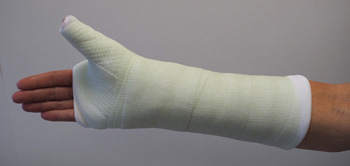 For some fractures, a cast that covers the forearm, wrist, and thumb may be used to help keep the bone fragments in place while they heal.
For some fractures, a cast that covers the forearm, wrist, and thumb may be used to help keep the bone fragments in place while they heal.
Fracture near the forearm. If the scaphoid is broken in the middle of the bone (waist) or closer to the forearm (proximal pole), healing can be more difficult. These areas of the scaphoid do not have a very good blood supply.
If your doctor treats this type of fracture with a cast, the cast may include the thumb and extend above the elbow to help stabilize the fracture
Bone stimulator. In some cases, your doctor may recommend the use of a bone stimulator to assist in fracture healing. This small device delivers low-intensity ultrasonic or pulsed electromagnetic waves that stimulate healing.
Surgical Treatment
If your scaphoid is broken at the waist or proximal pole or if pieces of bone are displaced, your doctor may recommend surgery. The goal of surgery is to realign and stabilize the fracture, giving it a better chance to heal.
Reduction. During this procedure, your doctor will administer an anesthetic or anesthesia and manipulate the bone back into its proper position. In some cases, this is done using a limited incision and special guided instruments. In other cases, it is performed through an open incision with direct manipulation of the fracture. For some fractures, your doctor may use a tiny camera called an "arthroscope" to aid in the reduction.
Internal fixation. During this procedure, metal implants—including screws and/or wires—are used to hold the scaphoid in place until the bone is fully healed.
The location and size of the surgical incision depends on what part of the scaphoid is broken. Sometimes, the screw or wire can be placed in bone fragments with a small incision. In other cases, a larger incision is needed to ensure that the fragments of the scaphoid line up properly. The incision may be made on either the front or the back of your wrist.
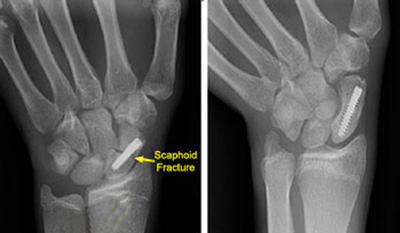 (Left) This x-ray shows a scaphoid fracture fixed in place with a screw. (Right) This x-ray was taken 4 months after surgery. The fracture of the scaphoid is healed.
(Left) This x-ray shows a scaphoid fracture fixed in place with a screw. (Right) This x-ray was taken 4 months after surgery. The fracture of the scaphoid is healed.
Bone graft. In some cases, a bone graft may be used with or without internal fixation. A bone graft is new bone that is placed around the broken bone. It can stimulate bone production and healing. The graft may be taken from your forearm bone in the same arm or from your hip.
RecoveryWhether your treatment is surgical or nonsurgical, you may be required to wear a cast or splint for up to 6 months or until your fracture has healed. Unlike most other fractures, scaphoid fractures tend to heal slowly. During this time, unless advanced activity is approved by your doctor, you should avoid the following activities:
- Lifting, carrying, pushing, or pulling more than one pound of weight
- Throwing with your injured arm
- Participating in contact sports
- Climbing ladders or trees
- Participating in activities with a risk of falling onto your hand, such as inline skating or jumping on a trampoline
- Using heavy or vibratory machinery
- Smoking (which can delay or prevent fracture healing)
Some patients have wrist stiffness after scaphoid fractures. This is more common in patients who wear a cast for a long time or require more extensive surgery.
It is important to maintain full finger motion throughout your recovery period. Your doctor will provide an exercise program, and may refer you to a trained hand therapist who will help you regain as much range of motion and strength in your wrist as possible.
Despite hand therapy and a great deal of effort by the patient during home therapy, some patients may not recover the same range of motion and strength that they had before their injury.
ComplicationsNonunion
A bone that fails to heal is called a "nonunion." Nonunions are more common after scaphoid fractures because the blood supply to the scaphoid bone is poor. Good blood supply to a bone is very important in fracture healing—since blood carries oxygen and nutrients to the site of the fracture to aid in healing.
If your scaphoid fracture does not heal, your doctor may consider surgery to insert a bone graft. There are several types of bone grafts. For nonunions, your doctor may use a special kind of graft with its own blood supply (vascularized graft). In the case of a fracture that has collapsed, your doctor may use a structural graft--possibly from your hip.
Avascular Necrosis
In scaphoid fractures—especially those in which the bone fragments have become displaced—the blood supply to the bone may be disrupted. If the blood supply to one of the fragments is reduced significantly or lost completely, that fragment of bone will not get enough nutrients and the cells will die. The bone will not heal properly if this occurs. This condition is called "avascular necrosis."
A vascularized bone graft is the most effective treatment for this condition—providing the bone has not collapsed significantly or arthritis has not developed in the wrist.
Arthritis
Over time, nonunion and avascular necrosis of the scaphoid can lead to arthritis of the wrist. Arthritis occurs when the articular cartilage in the joint becomes worn and frayed—sometimes to the point where bone rubs on bone.
Symptoms of arthritis in the wrist may include:
- Aching
- Stiffness
- Decreased range of motion in the wrist
- Pain with activities such as lifting, gripping, or weight bearing
Treatment for arthritis focuses on improving symptoms. At first, this may include taking anti-inflammatory medicine or over-the-counter analgesics, wearing a splint when the wrist is painful, and avoiding activities that aggravate the wrist. Sometimes, a steroid injection into the wrist may help relieve pain.
If conservative treatment does not relieve your symptoms, your doctor may recommend surgery. There are many types of procedures that can be performed for wrist arthritis.
New DevelopmentsFor specific fracture patterns, some doctors are now using a very small incision —less than 1/2-inch long—to reduce the fracture and to place a screw in the aligned scaphoid. This procedure is performed using a special x-ray machine to help guide the placement of the screw.
Additionally, your doctor may insert a small camera called an "arthroscope" into your wrist to look directly at the fracture. This may help with the reduction and the fixation of the bone and will decrease the surgical exposure needed for certain open procedures.
Current research centers on different types of bone grafts and bone graft substitutes to speed bone healing. Additional substances, such as Bone Morphogenic Proteins (BMP), are also being evaluated to improve healing potential.
Newer types of wrist braces may help prevent injury and better imaging may lead to earlier diagnosis of these difficult fractures.
If you found this article helpful, you may also be interested in Nonunions.
Source: http://orthoinfo.aaos.org/topic.cfm?topic=A00012
